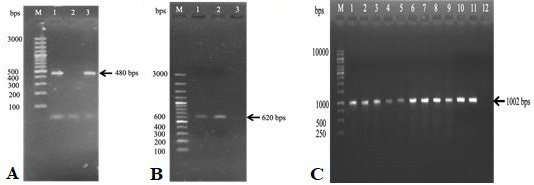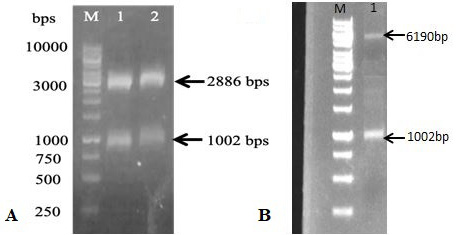Immune Protective Efficacy of Recombinant Outer Membrane Protein H of Pasteurella multocida B:2 Associated with Hemorrhagic Septicemia in Pakistan
Immune Protective Efficacy of Recombinant Outer Membrane Protein H of Pasteurella multocida B:2 Associated with Hemorrhagic Septicemia in Pakistan
Abida Mushtaque1, Ali Ahmad Sheikh1, Aamir Ghafoor1*, Wasim Shehzad2 and Nadeem Ahmad3
Molecular identification of P. multocida B:2 and Omph (A) M: O’Gene Ruler 100bp Plus DNA ladder, lane 1: the 480 bps species conserver region amplified by using KMT1T7 and KMT1SP6 primers, lane 2: negative control, lane 3: positive control; (B) M: O’Gene Ruler 100bp Plus DNA ladder, lane 1: the 620 bps serotype specific region amplified by using KMT1T7 and KMT1SP6 primers, lane 2: positive control, lane 3: negitive control. (C) M: O’Gene Ruler 1 kb DNA ladder, lane 1-10: amplified omph amplificaon, lane 11: positive control, lane 12: negitive control.
(A) Restriction digestion of pTZ57R/T plasmid cloned with ompH gene. The enzyme digesation confirmed the presence of gene of interest omph characterized by appearance of 1002 bps band and pTZ57R/T plasmid characterized by 2886 bps band (lane 1 and 2), M: O’Gene Ruler 1 kb DNA ladder. (B) the plasmid (pET-40b(+):omph) was digested with BamHI and SalI to futher confirm the cloning. The presence of two bands of 1002 and 6190 bps, confirmed the successful cloning of omphinpET-40(+) vector.
Total cell protein analysis of induced and uninduced transformed BL21 (DE3). (A) M is Page ruler plus prestained protein ladder, Lane 1-3 correspond to the total cell protein of induced BL21 (DE3) transformed cells and lane 4 corresponds to the total cell protein of uninduced BL21 (DE3) cells termed as negative control. (B) Qualitative analysis of purified rOmph protein (Lane 1, 2 and 3). (C) Immunoblotting of rOmpH protein. M: PageRuler protein ladder, lane 1-2: purified rOmph protein, lane 3: negative control, lane 4: histidine tag containing protein used as positive control.













